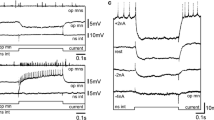Abstract
Tetanization of the ventrolateral nucleus of the thalamus, the red nucleus, and the sensory cortex produced long-term potentiation and depression of the efficiency of both excitatory and inhibitory connections in the neuronal micronetworks of the motor cortex in the cat. Rhythmic stimulation of various structures produced a variety of stable patterns of interneuronal connections in micronetworks. In monosynaptic excitation and disynaptic inhibition, the efficiency of inhibitory transmission was potentiated simultaneously with depression of the efficiency of excitatory transmission in the same post-synaptic cell. The efficiencies of synapses formed by axon collaterals of a given cell on its neighboring cells could change in different directions. These results may indicate that the sign (positive or negative) of modification may be determined by the activity of both cells, i.e., the pre- and post-synaptic cells.
Similar content being viewed by others
References
N. V. Veber, S. Sh. Rapoport, and I. G. Sil'kis, “Long-term homo- and heterosynaptic post-tetanic changes in the responses of neurons of the sensorimotor cortex,”Dokl. Akad. Nauk SSSR,281, No. 2, 486 (1985).
T. Sh. Labakhua, G. L. Bekaya, and V. M. Okudzhava, “Post-tetanic potentiation of inhibitory post-synaptic potentials of cat motor cortex neurons,” Dokl. Akad. Nauk SSSR,259, No. 4, 1013 (1981).
I. G. Sil'kis, “Long-term post-tetanic changes in the efficiency of inhibitory connections in thalamo-cortical neuronal networks,” Dokl. Akad. Nauk SSSR,337, No. 3, 388 (1994).
I. G. Sil'kis, “Excitatory interactions in the neuronal networks including auditory cortex cells and the medical geniculate body,” Zh. Vyssh. Nerv. Deyat.,44, No. 4-5, 762 (1994).
I. G. Sil'kis, “Inhibitory interactions in neuronal networks including auditory cortex cells and the medical geniculate body,”Zh. Vyssh. Nerv. Deyat.,44, No. 6, 1046 (1994).
I. G. Sil'kis, “Long-term changes in the efficiency of synaptic transmission in thalamo-cortical networks eliciting stimulation of the neocortex,” Zh. Vyssh. Nerv. Deyat.,45, No. 2, 321 (1994).
I. G. Sil'kis, S. Sh. Rapoport, N. V. Veber, and A. M. Gushchin, “Long-term homosynaptic depression of spike responses of cat motor cortex neurons,” Zh. Vyssh. Nerv. Deyat.,43, No. 5, 925 (1992).
I. G. Sil'kis, S. Sh. Rapoport, and N. V. Veber, “Long-term post-tetanic changes in the responses of neighboring neurons in microregions of the cat motor cortex,” Zh. Vyssh. Nerv. Deyat.,44, No. 1, 124 (1994).
V. M. Storozhuk, The Functional Organization of Somatic Cortex Neurons [in Russian], Nauk, Dumka, Kiew (1974).
A. A. Frolov and I. P. Murav'ev, Information Characteristics of Neuronal Networks [in Russian], Nauka, Moscow (1988).
A. Aertsen and G. L. Gerstein, “Evaluation of neuronal connectivity: sensitivity of cross-correlation,” Brain Res.,340, No. 1, 341 (1985).
A. Artola, S. Brocher, and W. Singer, “Different voltage-dependent thresholds for inducing long-term depression and long-term potentiation in slices of rat visual cortex,” Nature,347, No. 6288, 69 (1990).
N. J. Berman, R. J. Douglas, and K. A. C. Martin, “The conductance associated with inhibitory postsynaptic potentials are larger in visual cortical neurons in intact anaesthetised rats,” J. Physiol. (Lond.),418, 107 (1989).
M. S., Berry and V. W. Pentreath, “Criteria for distinguishing between monosynaptic and polysynaptic transmission,” Brain Res.,105, No. 1, 1 (1974).
J. V. Dickson and G. L. Gerstein, “Interactions between neurons in auditory cortex of the cat,” J. Neurophysiol.,6, No. 5, 1239 (1974).
J. J. Eggermont, “Neural interaction in cat primary auditory cortex. Dependence on recording depth, electrode separation and age,” J. Neurophysiol.,68, No. 4, 1216 (1992).
D. O. Hebb, The Organization of Behavior, Wiley, New York (1949), p. 62.
P. Heierli, F. De Ribaupierre, and Y. De Ribaupierre, “Functional properties and interactions of neuron pairs simultaneously recorded in the medial geniculate body of the cat,” Hear. Res.,25, No. 2/3, 209 (1987).
E. W. Kairiss, W. C. Abraham, D. K. Bilkey, and G. V. Goddard, “Field potential evidence for long-term potentiation of feed-forward inhibition in the rat dentate gyrus,” Brain Res.,401, No. 1, 87 (1987).
Y. Komatsu and M. Iwakiri, “Long-term modification of inhibitory synaptic transmission in developing visual cortex,” Neuroreport.,4, No. 7, 907 (1993).
Y. V. Liu, J. E. Disterhoft, and N. T. Slater, “Activation of metabotropic glutamate receptors induces long-term depression of GABAergic inhibition in the hippocampus,” J. Neurophysiol.,69, No. 3, 1000 (1993).
R. M. Mulkey, S. Endo, S. Shenolikar, and R. C. Malenka, “Involvement of a calcineurin/inhibitor-1 phosphatase cascade in hippocampal long-term depression,” Nature,369, No. 6480, 486 (1994).
G. J. Pacelli, W. Su, and S. R. Kelso, “Activity-induced depression of synaptic inhibition during LTP-inducing patterned stimulation,” Brain Res.,486, No. 1, 26 (1989).
S. Rapoport, I. Silkis, and N. Weber, “Long-lasting post-tetanic modifications of the synaptic efficacy in local networks of cat motor cortex neurons,” in: Neural Mechanisms of Learning and Memory. Open Network Conference, Trenby Printers Ltd., London (1990), p. 5/27.
T. Tsumoto, “Long-term potentiation and long-term depression in the neocortex,” Progr. Neurobiol.,39, No. 2, 209 (1992).
Additional information
Institute of Higher Nervous Activity and Neurophysiology, Russian Academy of Sciences, Moscow. Translated from Zhurnal Vysshei Nervnoi Deyatel'nosti, Vol. 45, No. 5, pp. 932–947, September–October, 1995.
Rights and permissions
About this article
Cite this article
Sil'kis, I.G. Long-term changes in the efficiency of excitatory and inhibitory connections in neuronal micronetworks of the motor cortex induced by tetanization of the thalamic nuclei and the sensory cortex. Neurosci Behav Physiol 27, 6–16 (1997). https://doi.org/10.1007/BF02463040
Received:
Revised:
Issue Date:
DOI: https://doi.org/10.1007/BF02463040




